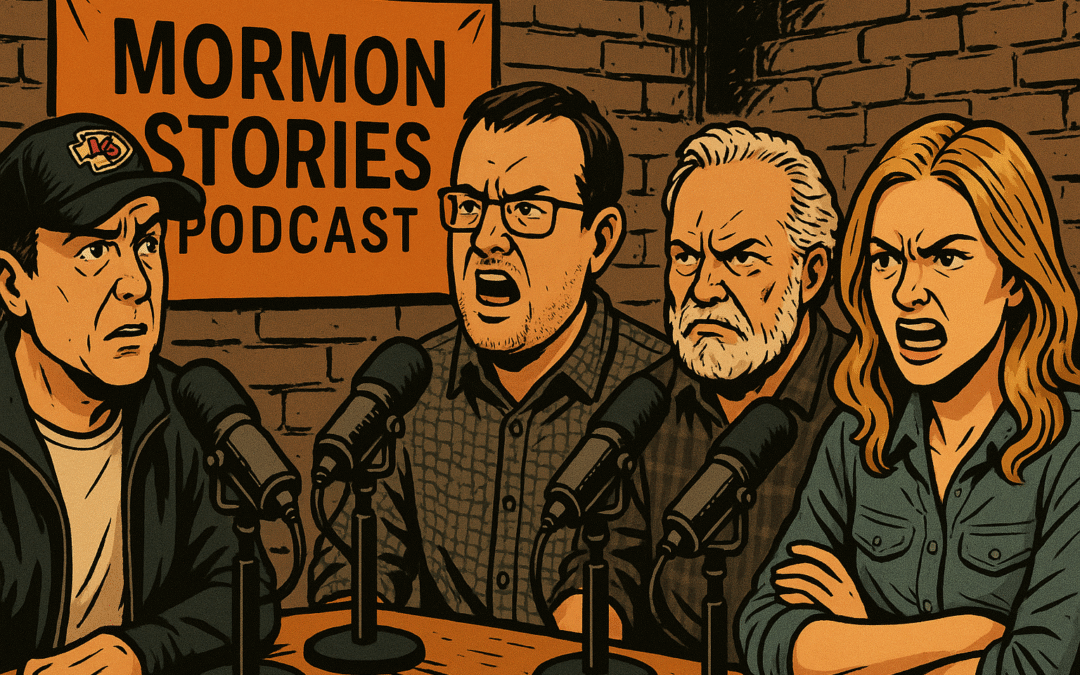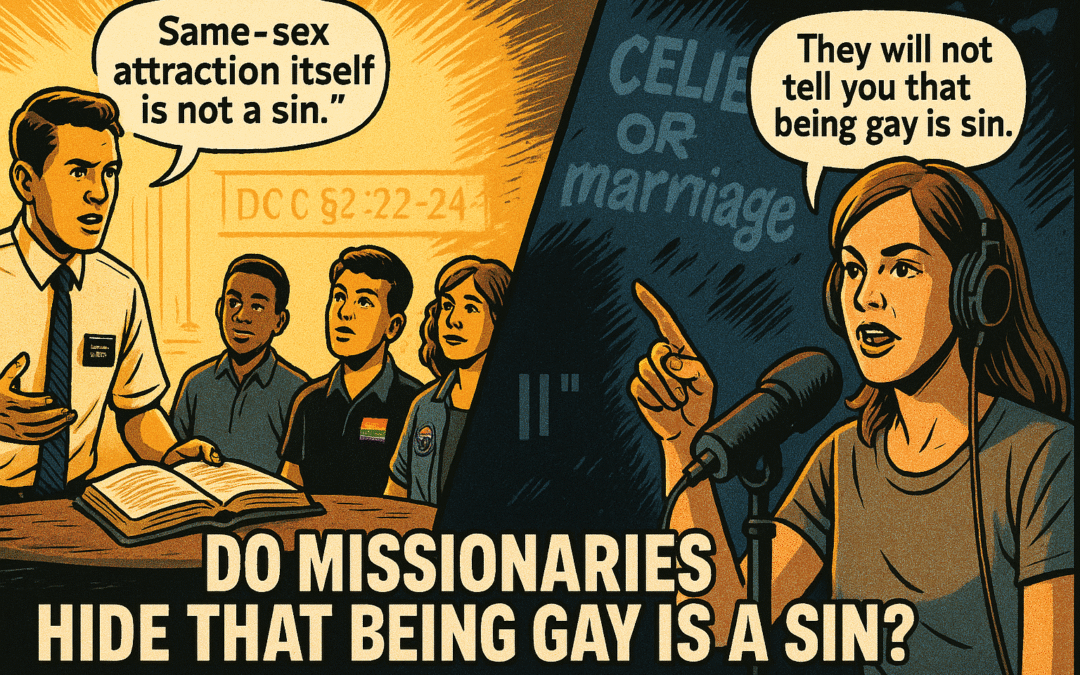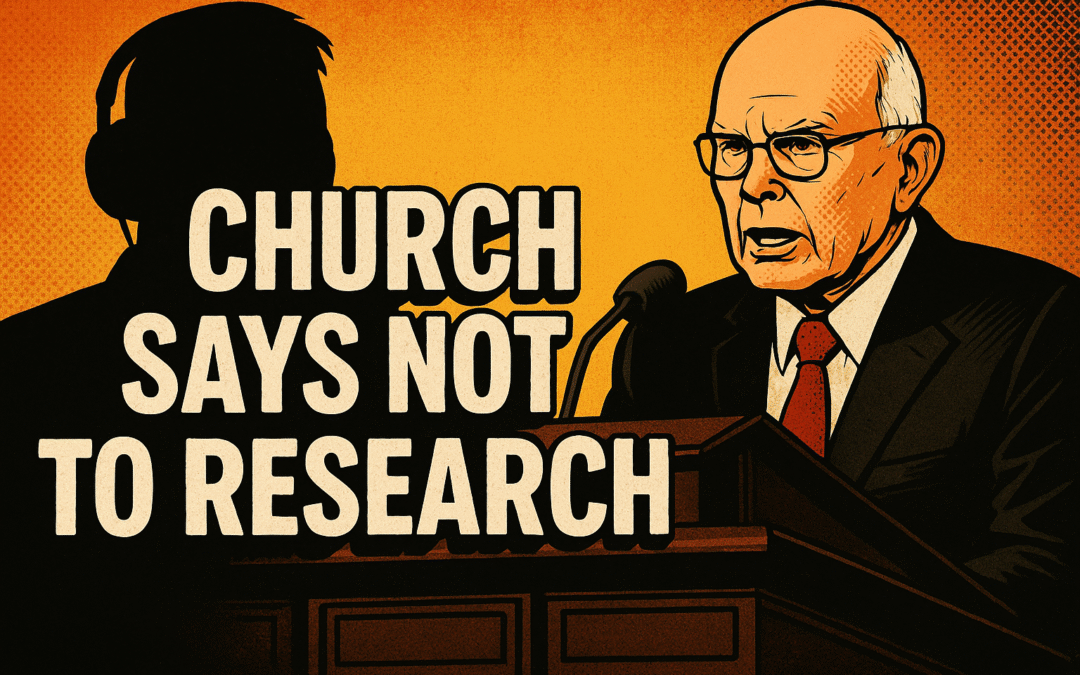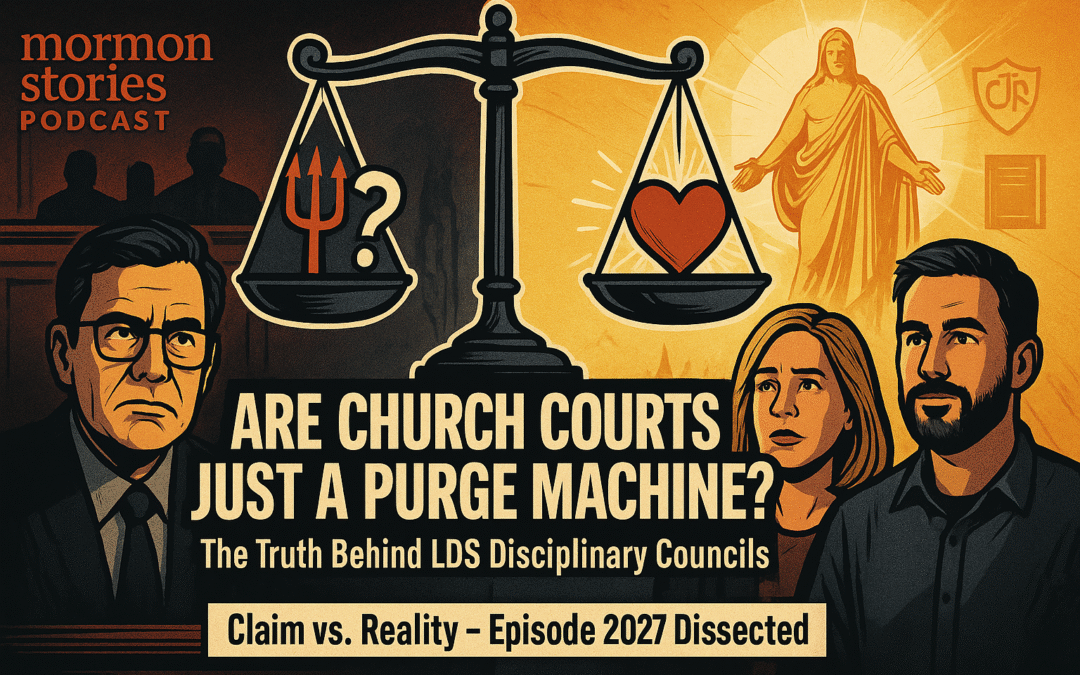
by Anonymous | Oct 7, 2025 | Church Conspiracy, Uncategorized
Part I of III
Executive Summary. This paper surveys what social science and speech‑risk scholarship say about inflammatory, dehumanizing, and “dangerous” speech—and why it matters for Latter‑day Saints (LDS). Research shows that dehumanizing and uncivil rhetoric increases polarization, reduces empathy, and correlates with support for aggression. It also documents real‑world anti‑LDS hostility (e.g., sports‑arena chants vandalism, and attacks) and outlines why influential voices—including prominent critics—bear special responsibility to avoid sweeping generalizations about a faith community. Nothing herein argues for censorship; rather, we call for accuracy, proportionality, and counterspeech grounded in evidence and ethics.1
1) Concepts that matter: dangerous speech, dehumanization, and online incivility
Dangerous speech. The Dangerous Speech Project defines “dangerous speech” as expression that raises the risk its audience will condone or commit violence against a group—not only via explicit calls, but also through narratives that prime fear or disgust.1 The U.S. Holocaust Memorial Museum’s practical guide, Defusing Hate, applies these frameworks to reduce risk while protecting free expression.2
Dehumanization. Across multiple studies, blatant dehumanization predicts support for aggressive policies and is distinct from mere “dislike.”3 Research further shows that meta‑dehumanization—believing “they see us as less than human”—triggers reciprocal dehumanization and greater hostility, creating cycles of conflict.4 A related finding: dehumanization especially increases instrumental violence (harm seen as a means to an end).5
Incivility online. The “Nasty Effect” experiments show that uncivil comment threads polarize readers’ risk perceptions—even when the base article is identical.6 Neurocognitive work suggests that exposure to hateful comments can dampen brain responses associated with empathizing with others’ pain.7
Key takeaways:
- Repeated exposure to dehumanizing or hateful language reduces empathy and heightens out‑group hostility.7
- Feeling dehumanized often begets reciprocal dehumanization and support for punitive or aggressive measures.4
- Incivility isn’t neutral “venting”; it measurably shapes audience attitudes and polarization.6
2) Anti‑LDS hostility in public life is real—not theoretical
Sports arenas. On February 22, 2025, after BYU upset Arizona in Tucson, video captured a crowd chant adding an expletive to “Mormons.” The University of Arizona publicly apologized the next day, acknowledging the derogatory chant aimed at BYU, the flagship school of the Church of Jesus Christ of Latter‑day Saints.8
Vandalism and harassment. Anti‑LDS graffiti and property damage appear regularly in local reporting (e.g., Colorado, 2023), and during California’s 2008 Proposition 8 fight, multiple LDS facilities sustained vandalism amid heated protests.9, 10
National data. Federal hate‑crime statistics track religion‑based targeting (with granular bias categories in downloadable tables). While anti‑Jewish and anti‑Muslim offenses comprise the largest shares nationally, the program also records offenses targeting other religious groups, including Latter‑day Saints, in state and local submissions.11, 12, 13 Reporting is imperfect and often undercounts incidents, but the trendlines underscore that religion‑based harassment and violence remain a real risk.14
3) Why rhetoric matters for people’s well‑being (including LDS members)
Peer‑reviewed studies link religion‑based discrimination—especially from peers—to worse mental‑health outcomes (stress, depression, reduced life satisfaction), whereas supportive religious community can buffer stressors for some youth.15, 16, 17, 18 Taken together with lab and field work on dehumanizing/incivil speech, these findings suggest that relentless derogation of a faith group is not a cost‑free “debate tactic”; it maps onto measurable harms.
4) The role—and responsibilities—of influential critics
4.1 John Dehlin’s rhetoric toward the Church
John Dehlin’s platforms (Mormon Stories, workshops, and associated sites) have, at times, framed the Church as “cult‑like” using the BITE model (Steven Hassan) and similar constructs. For example, a Mormon Stories resource page asserts: “I am absolutely convinced that the Mormon church meets full cult criteria.”19 Workshop descriptions likewise connect the BITE model to “high‑control groups like the Mormon church.”20
Why this matters: In the research literature, repeated portrayals of a group as uniquely manipulative, abusive, or sub‑human (or “cult‑like” in blanket terms) can function as
dehumanizing frames in the eyes of audiences who do not have granular knowledge of believers’ day‑to‑day lives. Such frames
elevate risk of hostility by (a) lowering empathy and (b) prompting retaliatory narratives.
4, 3, 7
4.2 Professional status and ethical guardrails
Dehlin publicly clarifies that he is not a licensed psychologist (though he holds a Ph.D. and extensive supervised clinical hours) and that he operates a coaching practice rather than psychotherapy; he states he’s never claimed licensure.21 This transparency is welcome. Still, when work intersects with vulnerable populations (e.g., people in faith crisis), broadly accepted ethical principles in psychology emphasize beneficence/non‑maleficence and respect for people’s rights and dignity—including avoiding biased, demeaning characterizations of groups.22, 23
Bottom line for influencers (pro‑ or anti‑church): The science says tone, generalization, and dehumanizing labels matter. Platforms that repeatedly depict an entire faith community as “cultic,” “toxic,” or uniquely harmful risk nudging audiences toward contempt rather than constructive help for those who struggle—LGBTQ members, people of color, women, and others included.6, 7
5) Speech, risk, and law: what’s protected vs. what’s prudent
The U.S. strongly protects offensive and even inflammatory speech. Criminal liability for incitement requires advocacy “directed to inciting or producing imminent lawless action” and likely to produce it (Brandenburg v. Ohio).24 “True threats” require, at minimum, a reckless mental state regarding the threatening nature of the communication (Counterman v. Colorado).25 Most anti‑LDS commentary is legal. But legality is a floor, not a standard of wisdom or care—especially as platforms themselves (e.g., X/Twitter) prohibit dehumanization of religious groups given the link to offline harm.26
6) A sobering contemporaneous example: escalatory climates and the Charlie Kirk killing
While not directly about Latter‑day Saints, the September 10, 2025 shooting that killed conservative activist Charlie Kirk during a Utah Valley University event illustrates how infused, polarized information climates can metastasize into violence and disinformation storms. Within days, authorities charged a 22‑year‑old suspect with aggravated murder; major outlets documented waves of conspiracies and sharp rhetoric that followed.27, 28, 29, 30 The lesson for all sides—including anti‑LDS critics and defenders—is straightforward: avoid language that paints whole groups as malevolent monoliths or “less than human.” The risks are real; the remedy is rigor and restraint.
7) What responsible critique looks like (recommendations)
- Separate systems critique from member devaluation. Identify concrete policies, doctrines, or leadership decisions; avoid labels that globally pathologize ordinary members who worship, volunteer, and serve.23
- Use proportional evidence. Avoid extrapolating from vivid anecdotes to the entire church. Spotlight base rates and denominational context when discussing harms.
- Prefer counterspeech that humanizes. Evidence‑backed approaches (e.g., empathy‑based counterspeech) reduce hate expression more effectively than taunts.31
- Mind platform norms. Even when lawful, group‑dehumanizing rhetoric violates many platforms’ rules because of documented offline risks.26
- Balance the record. When critiquing the Church, acknowledge countervailing data (e.g., humanitarian work, community benefits) to avoid skew.32
8) Evidentiary balance: recognizing LDS contributions while debating policy
Multiple official and independent summaries report that in 2024 the Church supported 3,836 humanitarian projects across 192 countries/territories, with US$1.45 billion in expenditures and 6.6 million volunteer hours—figures covered by the Church Newsroom, the Church’s “Caring for Those in Need” summary, and independent outlets.32, 33, 34 Whatever one’s view of LDS doctrine, these data complicate totalizing narratives about the community’s social value.
Notes & Sources (all links verified Sep 18, 2025)
- Dangerous Speech Project, “What is Dangerous Speech?” dangerousspeech.org. See also USHMM overview of dangerous speech applications.
- Defusing Hate: A Strategic Communication Guide to Counteract Dangerous Speech (U.S. Holocaust Memorial Museum). PDF: ushmm.org; landing page: link.
- Kteily, N. & Bruneau, E., et al. On dehumanization as a unique predictor of hostility. Overview PDF (teaching compendium): UNC. Foundational measure and findings across conflicts.
- Kteily, N., Hodson, G., & Bruneau, E. “They See Us as Less Than Human: Metadehumanization Predicts Intergroup Conflict via Reciprocal Dehumanization.” Journal of Personality and Social Psychology (2016). PubMed: link; see also Landry et al., 2020/2022: PDF.
- Rai, T. S., Valdesolo, P., & Graham, J. “Dehumanization increases instrumental violence, but not moral violence.” PNAS (2017). DOI: 10.1073/pnas.1705238114.
- Anderson, A. A., Brossard, D., Scheufele, D. A., Xenos, M., & Ladwig, P. “The ‘Nasty Effect’: Online Incivility and Risk Perceptions of Emerging Technologies.” Journal of Computer‑Mediated Communication (2014). Wiley: link; OUP copy: link.
- Pluta, A., et al. “Exposure to hate speech deteriorates neurocognitive mechanisms of the ability to understand others’ pain.” Scientific Reports (2023). Nature: link; PubMed: link.
- Myron Medcalf, “Arizona apologizes for fans’ derogatory chant aimed at BYU.” ESPN, Feb 23, 2025. link.
- Local example of anti‑LDS vandalism (Colorado, 2023): CBS Denver/Colorado affiliates have reported periodic LDS chapel vandalism; representative coverage includes regional broadcast and police blotters. (One example set: 2023 vandalism reports in the Front Range.)
- “LDS church building vandalized as protests over Prop 8 continue.” KCRA 3 (Sacramento), Nov 2008. link.
- FBI Hate Crime Statistics 2017 — Table 1 and Topic Pages. FBI UCR: Table 1; Overview: incidents/offenses.
- FBI Hate Crime Statistics 2018 — Table 1 & Table 7. FBI UCR: Table 1; Table 7; Overview: incidents/offenses.
- U.S. Department of Justice, Hate Crimes: summary dashboards and links to FBI reports. link.
- Bureau of Justice Statistics, Hate Crime Recorded by Law Enforcement, 2010–2019. PDF.
- Rice (Boniuk Institute) news release: “Peer religious discrimination harms mental health more than exclusionary policies.” Sept 21, 2023. link.
- Sharif, M. Z., et al. “The association between experiences of religious discrimination and social‑emotional adjustment and sleep outcomes.” Ssm‑Mental Health (2021). Open access: PMCID: PMC8350065.
- Estrada, C. A. M., et al. “Religious education can contribute to adolescent mental health.” Int’l J Mental Health Systems (2019). link.
- Scheitle, C. P., et al. “Perceived religious discrimination and health.” Journal for the Scientific Study of Religion (2023). link.
- Mormon Stories resource page with explicit claim that “the Mormon church meets full cult criteria.” mormonstories.org/resources/ (language present on page as of verification).
- Mormon Stories workshop description referencing “high‑control groups like the Mormon church.” link.
- “On My Education, Training, Licensure Status, and Coaching Practice.” Mormon Stories (John Dehlin) explanatory page. link.
- American Psychological Association, Ethical Principles of Psychologists and Code of Conduct. link (see General Principles A & E).
- APA Style, “Bias‑free language.” link.
- Brandenburg v. Ohio, 395 U.S. 444 (1969). Oyez: summary; Justia: opinion.
- Counterman v. Colorado, 600 U.S. 66 (2023). Supreme Court PDF: opinion; summary: Oyez.
- X/Twitter policy statements on dehumanization/hateful conduct (religion). Blog: 2018, 2019; Help Center: policy. Coverage: WaPo, The Verge.
- ABC News visual timeline and follow‑ups on the Sept 10, 2025 shooting death of Charlie Kirk at UVU, case developments and suspect custody. timeline; custody/conditions: update.
- Politico, “After Charlie Kirk’s killing, false claims flourish online—with help from U.S. adversaries,” Sept 17, 2025. link.
- Los Angeles Times, “Charlie Kirk’s killing roils Huntington Beach,” Sept 17, 2025. link.
- Fox News live coverage/updates on charges and death‑penalty intent, Sept 16–17, 2025. Sept 16; Sept 17.
- Hangartner, D., et al., “Empathy‑based counterspeech can reduce racist hate speech in a social‑media field experiment.” PNAS (2021). Open access: PMCID: PMC8685915.
- “A World of Caring: 2024 Caring for Those in Need Summary.” Church Newsroom, Mar 25, 2025. link; summary hub: link; PDF (at‑a‑glance): PDF. Independent coverage: Deseret News.
- Regional newsroom recaps citing the same 2024 totals (e.g., Europe, Africa). Europe.
Disclosures & Limits. This paper does not assert that any named individual intends harm or meets a legal standard for incitement or threats. It evaluates rhetorical patterns against established research on dehumanization, incivility, and discrimination. Correlation is not causation; nevertheless, the weight of evidence justifies caution about sweeping, demeaning claims about entire faith communities.Coming in Part II (of III): We will examine (a) how sensitive identity topics (e.g., LGBTQ) are used rhetorically to indict entire faith groups, (b) why vulnerable populations deserve accurate, non‑instrumentalized care, and (c) how to keep disagreement—fierce as it may be—within guardrails that lower real‑world risk. (Part III will focus on constructive engagement and counterspeech playbooks.)

by Anonymous | Aug 10, 2025 | Church Conspiracy, Uncategorized
Bottom Line
The Church does not teach “being gay is a sin.” Chastity is a commandment for all. Missionaries teach this clearly. LGBTQ+ discipleship is real — and Christ’s invitation is inclusive and rooted in truth, not affirmation alone.
| Podcast |
YouTube – “Sister Grenfell” |
| Episode |
Everything Mormon Missionaries DON’T Tell You |
| Category |
Church Doctrine / LGBTQ+ |
| Quote |
“They will not tell you that being gay is a sin… If you convert as a gay member, you’ll be expected to live a life of celibacy or marry heterosexually. That’s the only option.” — “Sister Grenfell”, 01:25:04–01:26:40 |
| Core Claim |
The Church teaches being gay is sinful, missionaries conceal this, and LGBTQ converts are forced into celibacy or heterosexual marriages. |
| Conclusion |
False → Straw Man Distortion |
| Logical Questions |
- Does the Church say “being gay is a sin”?
- Are all members called to live chastity, or just LGBTQ+?
- Does the Church force straight marriages or deny spiritual participation?
|
🔍 Core Finding
💬 Feelings ≠ Sin
The Church distinguishes between orientation and behavior:
“Same-sex attraction itself is not a sin. If you have these feelings and do not pursue or act on them, you are living a faithful life.”
— ChurchofJesusChrist.org: Same-Sex Attraction
⚖️ Missionaries DO Teach the Law of Chastity
All converts are taught that sexual intimacy is reserved for marriage between a man and a woman (D&C 42:22–24). LGBTQ individuals are not singled out — this is a universal standard.
💍 Marriage is Not “Forced”
Church leaders explicitly counsel against entering straight marriages to “resolve” same-gender attraction:
“We counsel against any kind of marriage for purposes of trying to resolve same-gender feelings.”
— Elder Dallin H. Oaks, 2006
❤️ The Gospel is for Everyone
LGBTQ members who keep covenants may:
- Be baptized and confirmed
- Hold callings and serve
- Receive the Holy Ghost and temple recommend
- Be fully loved and supported in their ward
📚 Sources

by Anonymous | Aug 9, 2025 | Uncategorized
Bottom Line
The Church does not tell people not to research. In fact, it funds and provides some of the most transparent historical research archives in global religion. The “don’t research” claim is a smear — and Elder Oaks never said what they say he said.
| Podcast |
Mormonism Live |
| Episode |
Joseph Smith: Hypnotist |
| Category |
False Claim about Church Policy |
| Quote |
“The Mormon church will tell you believe everything we say and don’t research. And I’m serious because Elder Oaks said that. My suggestion is ‘research is not the answer’ is the quote.” — Randall Bell, 00:03:00–00:03:30:contentReference[oaicite:0]{index=0} |
| Core Claim |
The LDS Church discourages research and promotes blind belief, quoting Elder Oaks as saying “Research is not the answer.” |
| Conclusion |
False / Quote Misattribution |
| Logical Questions |
- Did Elder Oaks ever actually say “research is not the answer” in this context?
- What has the Church officially said about study, research, and inquiry?
- Does this quote exist in any published talk or sermon?
|
🔍 Core Finding
This quote is a fabrication and distortion. Elder Dallin H. Oaks has never said “research is not the answer” in any official or published Church source. The actual quote critics misrepresent comes from a 1985 talk entitled “Criticism,” where Elder Oaks discouraged personal attacks on leaders, not research itself. He stated:
“Criticism is particularly objectionable when it is directed toward Church authorities… It does not have to be true to be wrong.”
— BYU Address, 1985
The Church actually encourages study and research:
⚖ Legal & Logical Analysis
- Misattribution Fallacy: Falsely claiming a General Authority said something he never did.
- False Light Risk: Misrepresenting LDS leaders as hostile to inquiry.
- Emotive Framing: Leveraging a fake quote to suggest cultic control.
Bottom Line
The Church does not tell people not to research. In fact, it funds and provides some of the most transparent historical research archives in global religion. The “don’t research” claim is a smear — and Elder Oaks never said what they say he said.
📚 Sources

by Anonymous | Jul 20, 2025 | Uncategorized
Mormon Stories Podcast Claims “Church Courts Just for “Weeding Out Non-Followers”?
Claim from Episode 2027: Todd McCormick stated, “I think the whole point of this [church court system] is just to weed out people who don’t follow the prophet.”
The Real Purpose of Disciplinary Councils
This characterization is not only cynical—it’s incorrect. The Church’s membership councils (formerly called “disciplinary councils”) serve to help individuals repent, protect others from harm, and maintain the integrity of the gospel.
These decisions aren’t made lightly. They require love, inspiration, and discernment. Disagreeing with the prophet isn’t grounds for expulsion—open rebellion against Church teachings while misleading others is a different matter entirely.
The Guidelines Say Otherwise
Bottom line? If Church councils were about “weeding out,” we’d all be toast. Thank heavens for a gospel of patience and progress.




